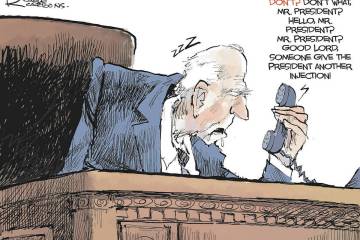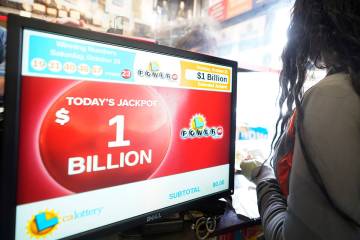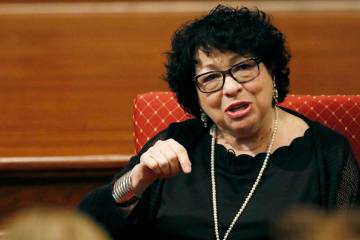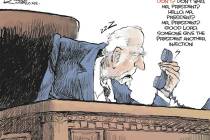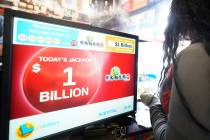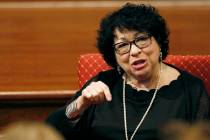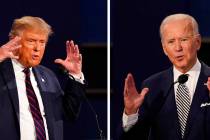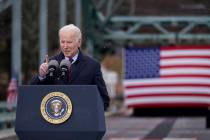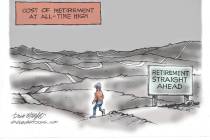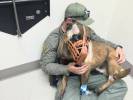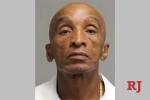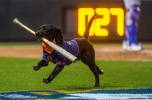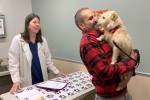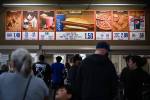Tragedy vivid, 35 years later
Does it seem like once a week we see in the news that another pedestrian has been killed on the streets of Las Vegas?
Well, in this case, “seeming” is believing. Last year, 42 pedestrians were killed on Las Vegas streets, according to Scott Magruder of the Nevada Department of Transportation. This year, we’re on a similar pace, with 17 pedestrian deaths through May 21. At that pace, we’ll beat last year’s total.
These dismal numbers are among the highest in the nation for our population. Of course, because our human traffic flow increases so markedly with tourists depending on the time of year, it would take a roomful of math geeks with their pocket protectors and slide rules to accurately calculate how we truly rank in this sorry statistic.
Not surprisingly, the two most dangerous streets to be walking across are Boulder Highway and the Strip. Boulder is a particular culprit because it is so wide — six lanes, and all wider than a normal thoroughfare, and speed limits between 45 and 55 mph. Your odds of crossing that highway on foot late at night without having a near-death experience are about the same as hitting all eight numbers on a Keno ticket. But when you lose, the penalty is far greater.
We can read about these fatalities in this newspaper, give a quick shake of our head at the foolishness of someone on foot challenging a moving automobile, and then move to the Jumble quiz or the gardening section and never think about them again. That is, until one of the victims is someone you know and care about.
Memory still vivid
To this day, I can never drive past UNLV on Maryland Parkway without visualizing the ethereal image of a pretty blond girl and her stately golden retriever waiting patiently to cross the street. It’s been 35 years, and the memory of them poised on the curbstone is as vivid as yesterday.
In most regards, Debbie Anderson was a typical freshman in the fall of 1976, a young woman excited about starting college and living away from home for the first time, in a campus dormitory.
She had graduated from Western High School with honors four months earlier and looked forward to the academic and social aspects of higher education, to the new friends she would make, the boys she would meet, the parties and football games she would attend. UNLV would be a huge challenge for her, but one she was confident she could overcome. She was more than battle-tested.
Debbie lost her father, a test pilot at Nellis Air Force Base, in a jet crash when she was just 4 years old. Two years later, her mom died of liver disease. Orphaned at six, she was taken in by her grandparents.
When she was 14, Debbie started suffering severe headaches. Doctors discovered a brain tumor. It was operable, but there were risks involved. She elected for the surgery, but was rendered totally blind.
Despite having undergone the trials of Job by her early teens, Debbie had no time for self-pity. She engaged in as normal a course of activities as possible in a world suddenly enveloped in darkness. She was just one year behind her class when she graduated from Western, and despite taking nearly a full course load her freshman year at UNLV, she earned a B-minus average.
I met her in the fall semester of her sophomore year, when she enrolled in an English 102 class I was teaching, her second attempt at the course. It’s a basic introduction to literature — short stories, poetry, drama — and the required course had given Debbie fits in her first attempt. She had dropped the class in mid-semester, finding the reading load too daunting.
I had been asked by the English Department chairman whether I would be willing to accommodate Debbie’s special needs in my class. She would require reading assignments weeks ahead of other students to obtain the necessary materials in Braille, and all her exams had to be administered orally. I eagerly consented, certain that I would learn more from her than vice versa.
I didn’t meet her until the first day of class. She was 10 minutes early, and by her side stood a handsome golden retriever named Midas, a guide dog with whom she had recently completed training. Flaxen-haired, vibrant and purposeful in manner and speech, Debbie showed me how to operate her tape recorder and asked permission to place it on my lectern.
“You can turn it off when you’re just telling jokes and stuff,” she said.
I patted Midas and told him I hoped he would have a good semester. He responded with a hollow stare followed by a big yawn and bowed his head. Just another disgruntled underclassman.
The other students in the class enthusiastically embraced Debbie and her dog. Several of them volunteered to read the assigned short stories and plays to her in the dorm. While the dog consistently resisted my lectures and scratched and growled from his cramped position at Debbie’s feet, she was more responsive, never allowing me to get by with any loose interpretations, questioning me on minor points of symbol, characterization and theme.
I came to learn much about her over the course of the semester. She said she felt blessed to be alive, that when the brain tumor had been discovered, she was told she had less than a year to live. So the loss of her vision in exchange for her life was a fair enough trade.
“The meadows and sunsets I see in my mind’s eye are every bit as beautiful as the ones you see,” she said. “And I’m vaguely aware when a light is on in a room, so I do have hope of seeing again some day.”
Heart keeps breaking
I have an indelible memory of leaving the university one day, watching Debbie and Midas standing on the median separating the lanes of traffic at Harmon Avenue and Maryland Parkway, waiting to cross as cars whizzed by going 45 to 50 mph (although the speed limit was a posted 35). It was a foreboding sight.
Less than one year after Debbie Anderson completed my literature class with a well-earned B-plus, she and Midas were struck by a speeding motorist at that very intersection. The dog was killed instantly. She died the next day.
The heavy blanket of grief that covered the UNLV community found its vent in a campus protest. More than 800 marchers, angered by the reluctance of public officials to lower the speed limit in front of the university, paraded through the intersection, imploring motorists to slow down. The march remained controlled and peaceful, a tribute to Debbie’s courage and spirit.
Eventually, the speed limit through the university zone was reduced to 25. But some seven years later, as memories faded, it was pushed back up to 30. At last check, it’s back to 25, which is still too high.
I drove by there just the other day, and I could swear I saw the ghostly outline of a girl and her dog poised to cross.
It broke my heart all over again.
Longtime Las Vegas resident and author Jack Sheehan’s column is published monthly in the Las Vegas Review-Journal. He says he loves the city, with all its wonder and weirdness, and thinks it offers the richest menu of writing material on the planet. Email him at jshee32110@aol.com.




